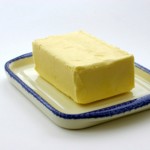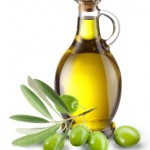I wrote about omega-3 fatty acids the last time, but, until I read Professor Robert L. Wolke's wonderful book, What Einstein Told His Cook, I didn't understand the name or remember much of the chemistry behind the fatty acids or fats themselves for that matter.
So let's start with a little chemistry, thanks to Wolke who is an emeritus professor of that discipline and wrote a Food 101 column for the Washington Post for a number of years.
Fats, also called triglycerides, are chemical substances whose molecules are made up of three fatty acid, long chains of carbon atoms hooked onto a connector called glycerol. The carbon atoms themselves usually have two hydrogen atoms and if every carbon in the fatty acid chain has both its soul-mate hydrogens then we call it a saturated fatty acid.
When one carbon hydrogen is lacking its pair of hydrogens, the fatty acid is termed monounsaturated; if two (or three or more) carbons find themselves without their hydrogens, the fatty acid is polyunsaturated.
The last carbon on a fatty acid's chain is termed the omega carbon from the final letter in the Greek alphabet. Omega-3 fatty acids, the good kind I've mentioned before, are missing hydrogens three carbons from the end of their chain.
So Omega-6 fatty acids, the much less healthful kind, lack hydrogens six places away from the omega end of the carbon line. And so on for Omega-9 fatty acids.
And while we're at it, if we're talking about a mostly saturated fat, it's likely to be a solid and from an animal source (or a chemistry lab). Those that are mostly unsaturated are usually from vegetable sources and are much more commonly liquids.
Two more chemistry concepts for today, then I'll quit. If you look at the composition of a particular vegetable oil, part may be saturated, part monounsaturated and part polyunsaturated. The proportions count in deciding if the veggie oil is good for you or not, as saturated fats aren't healthy.
When food manufacturers want to stack the deck and sell you solids, not liquids (think margarine versus canola oil), they can add hydrogens in a technical process. On the other hand, partially unsaturated fats are easier to spread than totally solid ones.
That process, hydrogenation, can produce molecules rarely found in nature and one of the consequences of doing so led to trans fats, where the hydrogens added end up on opposite sides of a carbon. Those trans fats turned out to be nasty beasts (this was suggested in the medical literature as early as 1988), causing heart disease, with one estimate of 20,000 additional deaths per year in the United States. That number was published in The American Journal of Public Health in 1995.
Thirteen years later, in January 2008, the state of California passed a law to minimize restaurants use of trans fats to less than half a gram per serving and in 2010 started to enforce that law. Apparently the state didn't think the restaurants would be able to comply with the new rules immediately and gave them two years to make changes. During all that time they could serve more than the limit of trans fats. Bakeries will have to comply with a similar law beginning on January 1, 2011.
I'll come back to the various kinds of fatty acids next time as there's more to add.
In the meantime, especially over the holidays, be aware of what you choose to eat.
Have a Merry (and healthy) Christmas.


